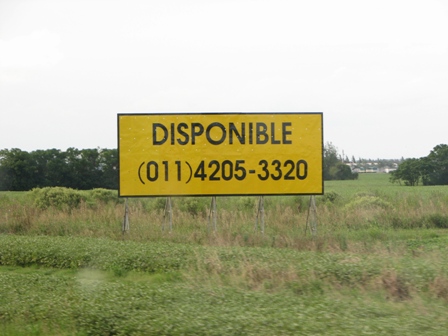A joint dispatch from Jodie and Andrea, RAN campaigners traveling through Argentina and Paraguay:
The trip between Buenos Aires, Argentina, and Asuncion, Paraguay, takes 16 hours by bus. Although about 10 of those hours pass in darkness, the remaining 6 leave no guess as to what whizzing views one misses during the bumpy night. There is roughly only one thing to look at as it expands in every direction, dominating the landscape on both sides of the road and spreading on and on toward the horizon. It’s soy, and it grows for as far as the eye can see.
These super-sized soy fields are the sowing of super-sized corporations that are proliferating their monocultured, genetically-engineered fields throughout South America. Look in the “Rural” section of Argentina’s Saturday news pages and you will find rows and rows of ads for millions of hectares of land in the Paraguayan savannas. One article in the same inset boasts that with soy at the helm, transgenic crops now cover 20 million hectares throughout Argentina. Another announces that Monstanto is ready to commercialize its second generation “Round-up Ready” (RR2) soy in Japan, the Philippines and Taiwan. A newsprint catalog of the industry’s worst transgressions on human rights and the environment framed as the “Superlatives” section in an agribusiness yearbook, these articles give us a look at who’s who in South American soy development.
The soy fever is so virulent that there is even a website dedicated to selling land in the virgin Gran Chaco ecosystem of Paraguay and developing it for soy production. The website boasts that the climate is perfect and soil fertility above average in this area, albeit there are still limitations like lack of roads. Don’t worry, though, this website also provides ideas for how to overcome such obstacles on your path to producing soy.
Besides the endless rows of soy, the bus passes hundreds of different signs that say things like “Sulfosato”. These strange and pseudo-scientific names are the trademarked lab results of biotech and pesticide companies encouraging soy farmers to increase their yield with genetically altered seed or kill off pests with industrial chemicals. There are also innumerable multiples of signs that read “disponible” (available), referring to plots of land being sold for soy production.
What does all of this mean? It means that Argentina and Paraguay are gripped by the soy rush. As soy for export (and increasingly for the production of Agrofuels) grabs all the land it can find, other crop production and cattle lands are displaced, putting additional pressure on intact forests across South America. Meanwhile, subsistence farmers and rural communities are shoved aside or bulldozed over. Tomorrow we head to some of those communities to see how they are fighting the agribusiness giants that are taking over the weekend paper and much of the continent.
